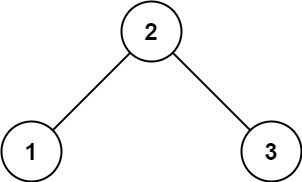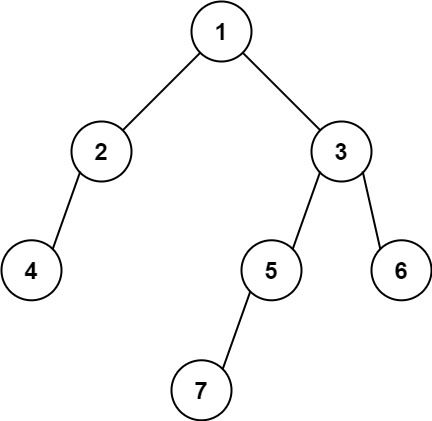| comments | difficulty | edit_url | tags | ||||
|---|---|---|---|---|---|---|---|
true |
中等 |
|
给定一个二叉树的 根节点 root,请找出该二叉树的 最底层 最左边 节点的值。
假设二叉树中至少有一个节点。
示例 1:
输入: root = [2,1,3] 输出: 1
示例 2:
输入: [1,2,3,4,null,5,6,null,null,7] 输出: 7
提示:
- 二叉树的节点个数的范围是
[1,104] -231 <= Node.val <= 231 - 1
BFS 找最后一层第一个节点。
# Definition for a binary tree node.
# class TreeNode:
# def __init__(self, val=0, left=None, right=None):
# self.val = val
# self.left = left
# self.right = right
class Solution:
def findBottomLeftValue(self, root: Optional[TreeNode]) -> int:
q = deque([root])
ans = 0
while q:
ans = q[0].val
for _ in range(len(q)):
node = q.popleft()
if node.left:
q.append(node.left)
if node.right:
q.append(node.right)
return ans/**
* Definition for a binary tree node.
* public class TreeNode {
* int val;
* TreeNode left;
* TreeNode right;
* TreeNode() {}
* TreeNode(int val) { this.val = val; }
* TreeNode(int val, TreeNode left, TreeNode right) {
* this.val = val;
* this.left = left;
* this.right = right;
* }
* }
*/
class Solution {
public int findBottomLeftValue(TreeNode root) {
Queue<TreeNode> q = new ArrayDeque<>();
q.offer(root);
int ans = 0;
while (!q.isEmpty()) {
ans = q.peek().val;
for (int i = q.size(); i > 0; --i) {
TreeNode node = q.poll();
if (node.left != null) {
q.offer(node.left);
}
if (node.right != null) {
q.offer(node.right);
}
}
}
return ans;
}
}/**
* Definition for a binary tree node.
* struct TreeNode {
* int val;
* TreeNode *left;
* TreeNode *right;
* TreeNode() : val(0), left(nullptr), right(nullptr) {}
* TreeNode(int x) : val(x), left(nullptr), right(nullptr) {}
* TreeNode(int x, TreeNode *left, TreeNode *right) : val(x), left(left), right(right) {}
* };
*/
class Solution {
public:
int findBottomLeftValue(TreeNode* root) {
queue<TreeNode*> q{{root}};
int ans = 0;
while (!q.empty()) {
ans = q.front()->val;
for (int i = q.size(); i; --i) {
TreeNode* node = q.front();
q.pop();
if (node->left) q.push(node->left);
if (node->right) q.push(node->right);
}
}
return ans;
}
};/**
* Definition for a binary tree node.
* type TreeNode struct {
* Val int
* Left *TreeNode
* Right *TreeNode
* }
*/
func findBottomLeftValue(root *TreeNode) int {
q := []*TreeNode{root}
ans := 0
for len(q) > 0 {
ans = q[0].Val
for i := len(q); i > 0; i-- {
node := q[0]
q = q[1:]
if node.Left != nil {
q = append(q, node.Left)
}
if node.Right != nil {
q = append(q, node.Right)
}
}
}
return ans
}/**
* Definition for a binary tree node.
* class TreeNode {
* val: number
* left: TreeNode | null
* right: TreeNode | null
* constructor(val?: number, left?: TreeNode | null, right?: TreeNode | null) {
* this.val = (val===undefined ? 0 : val)
* this.left = (left===undefined ? null : left)
* this.right = (right===undefined ? null : right)
* }
* }
*/
function findBottomLeftValue(root: TreeNode | null): number {
let ans = 0;
const q = [root];
while (q.length) {
ans = q[0].val;
for (let i = q.length; i; --i) {
const node = q.shift();
if (node.left) {
q.push(node.left);
}
if (node.right) {
q.push(node.right);
}
}
}
return ans;
}// Definition for a binary tree node.
// #[derive(Debug, PartialEq, Eq)]
// pub struct TreeNode {
// pub val: i32,
// pub left: Option<Rc<RefCell<TreeNode>>>,
// pub right: Option<Rc<RefCell<TreeNode>>>,
// }
//
// impl TreeNode {
// #[inline]
// pub fn new(val: i32) -> Self {
// TreeNode {
// val,
// left: None,
// right: None
// }
// }
// }
use std::cell::RefCell;
use std::collections::VecDeque;
use std::rc::Rc;
impl Solution {
pub fn find_bottom_left_value(root: Option<Rc<RefCell<TreeNode>>>) -> i32 {
let mut queue = VecDeque::new();
queue.push_back(root);
let mut res = 0;
while !queue.is_empty() {
res = queue.front().unwrap().as_ref().unwrap().borrow_mut().val;
for _ in 0..queue.len() {
let node = queue.pop_front().unwrap();
let mut node = node.as_ref().unwrap().borrow_mut();
if node.left.is_some() {
queue.push_back(node.left.take());
}
if node.right.is_some() {
queue.push_back(node.right.take());
}
}
}
res
}
}DFS 先序遍历,找深度最大的,且第一次被遍历到的节点。
# Definition for a binary tree node.
# class TreeNode:
# def __init__(self, val=0, left=None, right=None):
# self.val = val
# self.left = left
# self.right = right
class Solution:
def findBottomLeftValue(self, root: Optional[TreeNode]) -> int:
def dfs(root, curr):
if root is None:
return
dfs(root.left, curr + 1)
dfs(root.right, curr + 1)
nonlocal ans, mx
if mx < curr:
mx = curr
ans = root.val
ans = mx = 0
dfs(root, 1)
return ans/**
* Definition for a binary tree node.
* public class TreeNode {
* int val;
* TreeNode left;
* TreeNode right;
* TreeNode() {}
* TreeNode(int val) { this.val = val; }
* TreeNode(int val, TreeNode left, TreeNode right) {
* this.val = val;
* this.left = left;
* this.right = right;
* }
* }
*/
class Solution {
private int ans = 0;
private int mx = 0;
public int findBottomLeftValue(TreeNode root) {
dfs(root, 1);
return ans;
}
private void dfs(TreeNode root, int curr) {
if (root == null) {
return;
}
dfs(root.left, curr + 1);
dfs(root.right, curr + 1);
if (mx < curr) {
mx = curr;
ans = root.val;
}
}
}/**
* Definition for a binary tree node.
* struct TreeNode {
* int val;
* TreeNode *left;
* TreeNode *right;
* TreeNode() : val(0), left(nullptr), right(nullptr) {}
* TreeNode(int x) : val(x), left(nullptr), right(nullptr) {}
* TreeNode(int x, TreeNode *left, TreeNode *right) : val(x), left(left), right(right) {}
* };
*/
class Solution {
public:
int ans = 0;
int mx = 0;
int findBottomLeftValue(TreeNode* root) {
dfs(root, 1);
return ans;
}
void dfs(TreeNode* root, int curr) {
if (!root) return;
dfs(root->left, curr + 1);
dfs(root->right, curr + 1);
if (mx < curr) {
mx = curr;
ans = root->val;
}
}
};/**
* Definition for a binary tree node.
* type TreeNode struct {
* Val int
* Left *TreeNode
* Right *TreeNode
* }
*/
func findBottomLeftValue(root *TreeNode) int {
ans, mx := 0, 0
var dfs func(*TreeNode, int)
dfs = func(root *TreeNode, curr int) {
if root == nil {
return
}
dfs(root.Left, curr+1)
dfs(root.Right, curr+1)
if mx < curr {
mx = curr
ans = root.Val
}
}
dfs(root, 1)
return ans
}/**
* Definition for a binary tree node.
* class TreeNode {
* val: number
* left: TreeNode | null
* right: TreeNode | null
* constructor(val?: number, left?: TreeNode | null, right?: TreeNode | null) {
* this.val = (val===undefined ? 0 : val)
* this.left = (left===undefined ? null : left)
* this.right = (right===undefined ? null : right)
* }
* }
*/
function findBottomLeftValue(root: TreeNode | null): number {
let mx = 0;
let ans = 0;
function dfs(root, curr) {
if (!root) {
return;
}
dfs(root.left, curr + 1);
dfs(root.right, curr + 1);
if (mx < curr) {
mx = curr;
ans = root.val;
}
}
dfs(root, 1);
return ans;
}// Definition for a binary tree node.
// #[derive(Debug, PartialEq, Eq)]
// pub struct TreeNode {
// pub val: i32,
// pub left: Option<Rc<RefCell<TreeNode>>>,
// pub right: Option<Rc<RefCell<TreeNode>>>,
// }
//
// impl TreeNode {
// #[inline]
// pub fn new(val: i32) -> Self {
// TreeNode {
// val,
// left: None,
// right: None
// }
// }
// }
use std::cell::RefCell;
use std::collections::VecDeque;
use std::rc::Rc;
impl Solution {
fn dfs(root: &Option<Rc<RefCell<TreeNode>>>, cur: i32, max: &mut i32, res: &mut i32) {
if root.is_none() {
return;
}
let root = root.as_ref().unwrap().borrow();
Self::dfs(&root.left, cur + 1, max, res);
Self::dfs(&root.right, cur + 1, max, res);
if *max < cur {
*max = cur;
*res = root.val;
}
}
pub fn find_bottom_left_value(root: Option<Rc<RefCell<TreeNode>>>) -> i32 {
let mut max = 0;
let mut res = 0;
Self::dfs(&root, 1, &mut max, &mut res);
res
}
}
